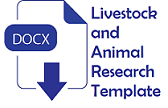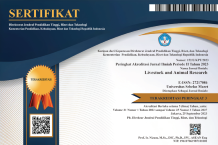Farmers’ behavior and the potential results of cattle-oil palm integration in South Sumatra's oil palm replanting area
Abstract
Objective: Replanting of oil palm plantations needs to be done to ensure long-term supply. However, problems arise due to the reduced income of farmers during the non-productive period of oil palm plantations, so there are various farmers’ behaviors in responding to this situation. One effort to increase farmers' income is through cattle-oil palm integration. This paper aims to analyze farmers’ behavior, the factors that influence it, and the potential yield obtained from the integration of cattle into oil palm in replanting fields.
Methods: The research was conducted using case studies in Cinta Damai Village, Sungai Lilin District, Musi Banyuasin Regency, South Sumatra, from November 2019 to November 2020. The survey was conducted on 35 farmers to assess behavior and factors that could influence it. Meanwhile, the potential yield of cattle-oil palm integration was measured through a demonstration plot of 1 ha of odot grass planting and processing of cow manure waste. Behavioral data were analyzed using path analysis, while the potential yield was analyzed descriptively.
Results: The results showed that farmers have behaviors that support the cattle-oil palm integration business. Factors that directly influence this behavior are land area and socio-economic motivation. Meanwhile, socio-economic motivation through success belief has a significant effect on farmers’ behavior.
Conclusions: The farmers' behaviour regarding the implementation of cattle-oil palm integration in oil palm replanting areas had criteria of poor, medium and good, with percentages of 5.71%, 25.71% and 68.51% respectively. The factors that directly influence this behaviour are the area of oil palm replanting area and the socio-economic motivation of the farmers. The potential results obtained from implementing cattle-oil palm integration are 1) forage for livestock (FFL) from odot grass, and 2) manure and liquid organic fertilizer (LOF) from cow dunk.
Keywords
Full Text:
PDFReferences
- Statistika.com. 2020. Infographics: Which countries produce the most palm oil?; c2020 [cited 2020 Mei 3]. Available from: https://www.statista.com/chart/23097/amount-of-palm-oil-produced-in-selected-countries/
- CPOPC. 2021. Palm oil supply and demand outlook report 2021. c2021 [cited 2021 Maret 22]. Available from: http://www.cpopc.org
- Purba, J. H. 2019. Replanting policy of Indonesian palm oil plantation in strengthening the implementation of sustainable development goals. IOP Conf. Ser. Earth Environ. Sci. 336:012012. Doi: 10.1088/1755-1315/336 /1/012012
- BBSDLP. 2020. Peta potensi peremajaan sawit rakyat Indonesia. Badan Penelitian dan Pengembangan Pertanian Press, Jakarta.
- Sudaryanto, T. 2017. Palm oil and beef cattle integration system: A strategy to accelerate beef production in Indonesia. Food and Fertilizer Technology for the Asian and Pacific Region (FFTCAP). c2017 [cited 2021 January 20]. Available from: https://ap.fftc.org.tw/article/1159
- Rusdiana, S. and C. Talib. 2019. Kebijakan pemerintah meningkatan usaha sapi potong di peternak. SOCA J. Sos. Ekon. Pertan. 13(3):380–395.
- Mathius, I. 2008. Pengembangan sapi potong berbasis industri kelapa sawit. Pengemb. Inov. Pertan. 1(2):206–224.
- Pinardi, D., D. Mulyono, D. S. Wahyuni, and M. Surachman. 2020. Development of palm oil-cattle integration program to support self-sufficiency of beef and development of human resources. J. Ilmu-Ilmu Peternak. 30(1):40–49. Doi: 10.21776/ub.jiip.2020.030.01.05
- Silalahi, F. R., A. Rauf, C. Hanum, and D. Siahaan. 2019. Potential of beef and biogas from integration of beef cattle-oil palm in Indonesia. IOP Conf. Ser. Earth Environ. Sci. 443(012075):1–9. Doi: 10.1088/1755-1315/443/1/012075
- Saad, M. Z., and K. Azhar. 2015. Issues of ruminant integration with oil palm plantation. J. Oil Palm Res. 27(4):299–305.
- M. A. Ayob and M. A. Kabul. 2009. Cattle integration in oil palm plantation through systematic management. Proceeding The 1st International Seminar on Animal Industry 2009. Faculty of Animal Science. p:66–73.
- Bremer, J. 2019. Driving smallholder cattle production in Indonesia. c2019 [cited 2021 January 30]. Available from: www.crawfordfund. org/ awards/crawfor-d-fund-student-awards/
- Matondang, R. H. and C. Talib. 2015. Model Pengembangan sapi Bali dalam usaha integrasi di perkebunan kelapa sawit. Wartazoa. 25(3):147–157.
- Silalahi, F. R. L., A. Rauf, C. Hanum, and D. Siahaan. 2018. The characteristic and problem of beef cattle-palm oil integration in Indonesia. International Conference on Agribusiness, Food, and Agro-Technology. IOP Conf. Ser. Earth Environ. Sci. 205(012016):1–10. Doi: 10.1088/1755-1315/-205/1/012016
- Riswani, R., A. Mulyana, and Y. Yunita. 2012. Analysis of factors influencing plasma farmers to adopt cattle and palm oil integrated system in South Sumatera, Indonesia. [Online]. Available from: http://repository.unsri.ac.id/id/eprint/23277. Doi: 10.5539/jas.v5n12p47
- Hutapea, Y., P. A. P. Hutabarat, and T. Thamrin. 2010. Peningkatan nilai tambah agribisnis melalui penerapan inovasi teknologi usahatani padi: Studi kasus kegiatan Primatani Kabupaten Musi Rawas, Sumsel. JPPT. 13(1):52–62.
- Skinner, B. F. 1938. The behavior of organisms: an experimental analysis. Appleton-Century. Available from: https:-//psycnet.apa.org/record/1939-00056-000.
- Lewin, K. 1936. Principles of topological psychology. New York-London. McGraw Hill, New York.
- Adijaya, I. N., and I. M. R. Yasa. Hubungan konsumsi pakan dengan potensi limbah pada sapi Bali untuk pupuk organik padat dan cair [internet]. Bptpbali; c2012 [cited 2020 July 20]. Available from: http://-bengkulu.litbang.pertanian.go.id/ind/images/dokumen/peternakan/bptpbali.pdf
- Dhakal, A., G. Cockfield, and T. N. Maraseni. 2015. Deriving an index of adoption rate and assessing factors affecting adoption of an agroforestry-based farming system in Dhanusha District, Nepal. Agrofor. Syst. 89(4):645–661. Doi: 10.1007/s10457-015-9802-1
- Gil, J. D. B., R. Garrett, and T. Berger. 2016. Determinants of crop-livestock integration in Brazil: Evidence from the household and regional levels. L. Use Policy. 59:557–568. Doi: 10.1016/j.landusepol.2016.09.022
- Islam, A. H. M. S., B. K. Barman, and K. Murshed-e-Jahan. 2015. Adoption and impact of integrated rice-fish farming system in Bangladesh. Aquaculture. 447:76–85. Doi: 10.1016/j.aquaculture.2015.01.006
- Widiyastuti, E., Widiyanti, and Sutarto. 2016. Persepsi petani terhadap pengembangan system of rice intensification (SRI) di Kecamatan Moga Kabupaten Pemalang. Agrista. 4(3):476–485.
- Greiner, R., and D. Gregg. 2011. Farmers’ intrinsic motivations, barriers to the adoption of conservation practices and effectiveness of policy instruments: empirical evidence from northern Australia. L. Use Policy. 28:257–265. Doi: 10.1016/j.landusepol.2010.06.006
- Maybery, D., L. Crase, and C. Gullifer. 2005. Categorizing farming values as economic, conservation, and lifestyle. J. Econ. Psychol. 26:59–72. Doi: 10.1016/-j.joep.2003.10.001
- Mellon-Bedi, S., K. Descheemaeker, B. Hundie-Kotu, S. Frimpong, and J. C. J. Groot. 2020. Motivational factors influencing farming practices in northern Ghana. NJAS- Wageningen J. Life Sci. 92:100326. Doi: 10.1016/j.njas.2020.100326
- Daru, T., A. Yulianti, and E. Widodo. 2014. Potensi hijauan di perkebunan kelapa sawit sebagai pakan sapi potong di Kabupaten Kutai Kartanegara. Pastura. 3(2):94–98.
- Marlina, E. T., T. B. A. Kurnani, Y. A. Hidayati, and D. Z. Badruzzaman. 2017. Penyusutan dan penurunan nisbah C/N pada vermin composting campuran feses sapi perah dan jerami padi menggunakan Eisenia fetida. Jurnal Ilmu Ternak. 17(2):114–119.
- Park, J., K. H. Cho, M. Ligaray, and M. Choi. 2019. Organic matter composition of manure and its potential impact on plant growth. Sustainability. 11(8):2346. Doi: 10.3390/su11082346
- Rahman, M.M., M. A. M. Salleh, U. Rashid, A. Ahsan, M. M. Hossain, and C. S. Ra, 2014. Production of slow release crystal fertilizer from wastewaters through struvite crystallization—A review. Arab. J. Chem. 7:139–155. Doi: 10.1016/j.arabjc.2013.10.007
Refbacks
- There are currently no refbacks.










